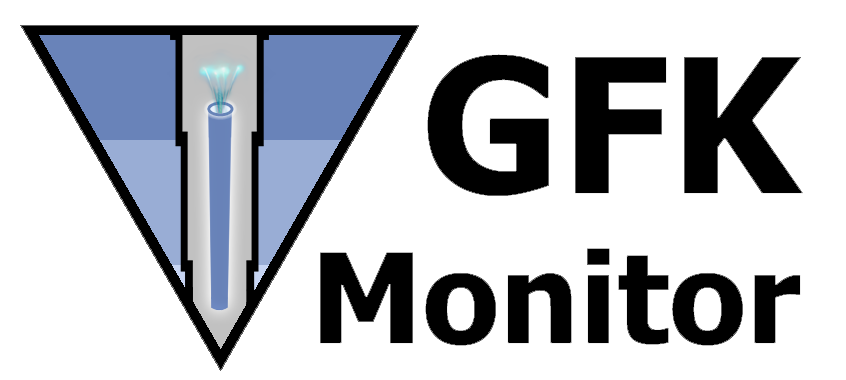Primary goals
The goal of the GFK-Monitor project is to develop a system integrity management system for geothermal plants that leverages operational data, integrates innovative fiber optic cable technology monitoring techniques, and standardizes monitoring procedures to enable
- Increase the production and operational reliability of geothermal plants and their efficiency
- Minimize or avoid potential environmental impacts
To achieve these overall goals in the project, the work outlined below is necessary.

Work packages
AP1: Production and structural stability of the well
An important aspect in the context of the production safety of a geothermal well is the verification of the integrity of the casing and cementation. The existing measurement technology for verification is currently only carried out at one point in time, in individual cases also at predefined intervals, and therefore does not provide conclusive, comprehensive safety during operation. Improved monitoring to verify well integrity is useful, on the one hand, to better meet regulatory requirements and to detect negative impacts on rig operations and potential environmental impacts at an early stage. On the other hand, it can also help to increase technology acceptance, since at times concerns of a negative impact of the well on the aquifers overlying the reservoir are raised in citizen dialogues. Another aspect that is often cited there is the seismicity induced by geothermal drilling. For the monitoring of microseismicity, some projects are currently being carried out, but the optimization of the monitoring and the derivation of the relevant parameters for geomechanical predictions are far from being conclusively investigated. Innovative monitoring, for example by using telecommunication lines, can provide a higher level of certainty here especially for an areal assessment of potential impacts. The same applies to the monitoring of subsidences, which must be carried out at a geothermal site according to official requirements, but for which no satisfactory procedures have yet been established either.
The production reliability and thus the economic efficiency of geothermal plants are technically also repeatedly negatively affected by the failure of the production pump. Monitoring of the deep well pump by means of integrated monitoring could detect changes and impairments of the pump due to e.g. chemical deposits (scalings) at an early stage, thus optimizing the operation control and thus extending the service life of the deep well pump.
AP2: Reservoir-side operational safety and sustainable management
The temperature of the produced thermal water and the inflow from the reservoir are the sensitive parameters for the economic efficiency of a geothermal operation. A reduction of the production temperature due to temperature losses or due to a thermal short circuit with the injection well has a direct negative impact on the economic reliability of operation. However, knowledge of the actual local and temporal dynamic thermal and hydraulic conditions along the well and in the reservoir is very limited, since the effort to obtain corresponding depth data is very high and technically limited. Up to now, the determination of the reservoir characteristics is only done by elaborate seismic programs or measurements in the already drilled borehole, respectively during the drilling process. Once the rig is in operation, measurements can only be made at the surface, during shutdowns with renewed downhole measurements, each of which again involves a risk to the well, or, in exceptional cases, on individual suspended probes. A determination of the dynamic flow behavior existing in the reservoir via the use of tracer substances and a monitoring of the pressure, inflow, stress and temperature conditions in the reservoir during the operating phase integrated into the geothermal wells can clearly support predictions about possible developments of the sensitive parameters, optimize the mode of operation and thus ensure an economically safe and sustainable management of the reservoir.
To better evaluate sustainable reservoir management and operational reliability, tracer tests were conducted on some individual geothermal facilities. Among other things, these tests provide the sole means of evaluating hydraulic flow behavior over a long reservoir distance, such as between production and injection wells, and thus provide valuable information for sustainable reservoir management and safe operation. These tests will be combined with FOC monitoring in the planned project to provide a holistic assessment of possible changes and monitoring techniques in the reservoir to analyze the operational efficiency. In addition, the application of tracer tests will be assessed and adapted as a systematic data collection for sustainable management and system integrity of geothermal plants and with reference to the use in the entire reservoir.
AP3: System integrity management
The present project focuses on innovative monitoring for the aspects of production and operational safety described above in order to improve the overall system integrity of geothermal plants. The monitoring is based on fiber optic cable (FOC) technology, as it can be used in a variety of ways in all the areas mentioned above. In addition, the unique advantage of FOC measurements is that they offer the possibility to provide high temporal resolution and continuous data of temperature (DTS), strain (DSS) and acoustics (DAS) as well as, by integrating additional sensors, data e.g. to measure pressure at different depths along the entire drilling section during operation. In addition, existing fiber optic cable infrastructure, such as telecommunication lines, can be used synergistically for geothermal issues, allowing important data to be collected over a larger area.
